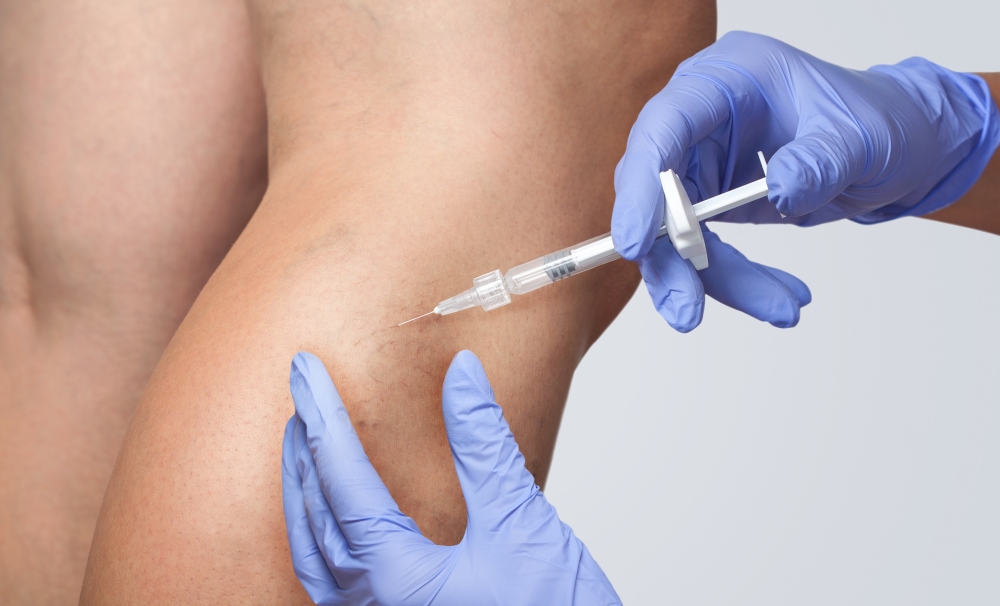Sclerotherapy is a widely used non-surgical procedure for the removal of varicose veins and spider veins. The method involves the doctor injecting an irritating sclerosant…
Why Does Skin Pigmentation Sometimes Occur After Sclerotherapy?

Sclerotherapy is a widely used non-surgical procedure for the removal of varicose veins and spider veins. The method involves the doctor injecting an irritating sclerosant solution into the vein. The sclerosant causes the vein to swell and later shrink, cutting off the blood flow in the faulty vein.
Some people who undergo sclerotherapy experience skin pigmentation. The latter is part of a normal healing process when a small amount of blood gets trapped in the veins during treatment.
As the body continues to heal the treated vein, excess hemoglobin gets released into the skin. The hemoglobin converts to hemosiderin which sits on the skin and causes skin discoloration.
Why Do Some Patients Develop Pigmentation After Sclerotherapy?
Pigmentation is a rare minor side effect of sclerotherapy. The chances of getting skin pigmentation after sclerotherapy can range from as low as 1% to around 30%. Usually, the pigmentation occurrence depends on multiple factors — such as the doctor’s skills, the sclerosant strength, the skin complexion, and the severity of the varicose or spider veins under treatment.
Usually, pigmentation happens when the skin gets stained by an iron pigment — such as hemoglobin. This side effect often happens to people who have large veins treated, but the pigmentation can disappear on its own. You can also help prevent skin pigmentation with simple measures such as wearing gradient compression stockings.
What Are the Risk Factors for Skin Pigmentation After Sclerotherapy?
Some people can be prone to pigmentation, yet others may never experience this mild adverse effect. Here are the main factors which contribute to the occurrence of pigmentation.
Severe Varicose Veins
Severe varicose veins can be the cause of skin discoloration. The vein exerts excess pressure on the delicate blood capillaries. This extra pressure engorges the capillaries such that hemoglobin and the red blood cells get pushed into the dermis, causing skin stains.
This pigmentation can darken the skin, and even after successful sclerotherapy, the pigmentation may not disappear. If you have pigmentation before the treatment, the chances are high that the stains will take some time to fade away.
However, the pigmentation becomes lighter after the treatment and fades away after some time. The fading process may take a few months, but it can clear off more quickly with the help of gradient compressions stockings.
Fragile Blood Vessels
Older patients tend to have more fragile blood vessels. Older patients can also have a less efficient blood circulation mechanism, increasing the chances of pigmentation.
The Injection Technique
Veins are quite sensitive and require careful handling. For the best results, you should only work with a seasoned vein specialist. The specialist should first examine your skin and determine the best quantity of sclerosant solution to use. Excess pressure when injecting the sclerosant or extra concentration of the sclerosant can increase the chances of pigmentation.
How Can You Minimize the Appearance of Pigmentation After Sclerotherapy?
Sclerotherapy is a safe procedure, although it requires multiple treatments to show the best results. Research suggests that sclerotherapy effectively gets rid of spider veins in up to 90% of cases. Skin pigmentation is one of the rare side effects that might happen after the procedure. Here are some tips to minimize the appearance of pigmentation after sclerotherapy.
Follow Post-Sclerotherapy Aftercare Instructions From Your Vein Specialist
Your doctor will provide you with post-sclerotherapy aftercare instructions that you must follow. These instructions can be as simple as avoiding excess exposure to the sun and staying hydrated. You should also use your gradient compression stockings well to facilitate recovery and reduce the risk of skin pigmentation.
Avoid Iron Supplements Unless Your Doctor Says Otherwise
Iron contains hemoglobin, which is the core cause of skin pigmentation after sclerotherapy. Avoid multivitamins that contain iron unless your doctor advises you to take them.
Avoid Excessive Exposure to Sunlight
Your doctor may tell you to stay away from excessive direct sunlight for at least two weeks. Since the sclerotherapy injection may cause inflammation, sunlight may facilitate dark spots in the treatment area.
What Steps Should You Take If You Have Skin Pigmentation?
Skin pigmentation can be problematic, but it should not be a cause for alarm. If the presence of dark or brown spots on your skin bothers you, reach out to your vein specialist for more details. Your doctor should then closely examine the pigmentation and recommend the ideal solution.
The most effective method for removing pigmentation involves the use of medical-grade lasers or intense pulse light. These lasers use high beam strength to reduce skin patches. Here are other practical steps to adhere to during the recovery period:
- Use gradient compression stockings to minimize the formation of blood clots in the treated superficial veins.
- Avoid strenuous activities in the first two weeks after the treatment.
- Use home remedies such as aloe vera, green tea, or licorice. These remedies may effectively lighten pigmentation. However, you should consult your health care provider first before you apply any of them.
Are You Ready to Get Sclerotherapy Treatments?
Sclerotherapy is one of the best treatments for varicose veins. However, the procedure comes with a few minor side effects, such as skin pigmentation, which only happens to some people. Pigmentation creates patches on the skin. The patches may disappear on their own in a few days or months.
If you plan to have sclerotherapy and worry about pigmentation, find the best vein specialist to help you. For more information about pigmentation after sclerotherapy, use My Vein Treatment’s vein specialist locator tool to connect with the best vein specialist for your needs.






Responses